There is a moment, just before the summit, when the air grows thin, the path narrows, and silence settles like a veil. In that stillness – high above the tree line, beyond the noise of the world – you begin to understand why the ancient Greeks built shrines on these lofty heights. Far from the bustling cities and sun-bleached sanctuaries of the coast, the mountains were considered sacred thresholds: places where earth touched sky and humans might draw near the divine.
While most visitors to Greece flock to storied sites like Knossos or the Parthenon, few venture to the windswept ridges where rituals once echoed and fires burned beneath open skies. Scattered across the highlands are the remains of mountaintop sanctuaries – places of offering and awe, often dedicated to Zeus in his most elemental forms: storm-bringer, sky-lord, protector, and punisher. These were not serene temples of marble and geometrical order, but wild altars to a god of weather and will.
 
Here, we’ll journey to six of these sacred summits, where myth and archaeology intertwine, and the ascent itself becomes part of the story. The month of May is an ideal time to explore: the trails are dry, the skies clear, and the scent of pine and wild thyme lingers in the air like an ancient invocation. So, lace up your boots – there are mountains to climb, and the gods are waiting.
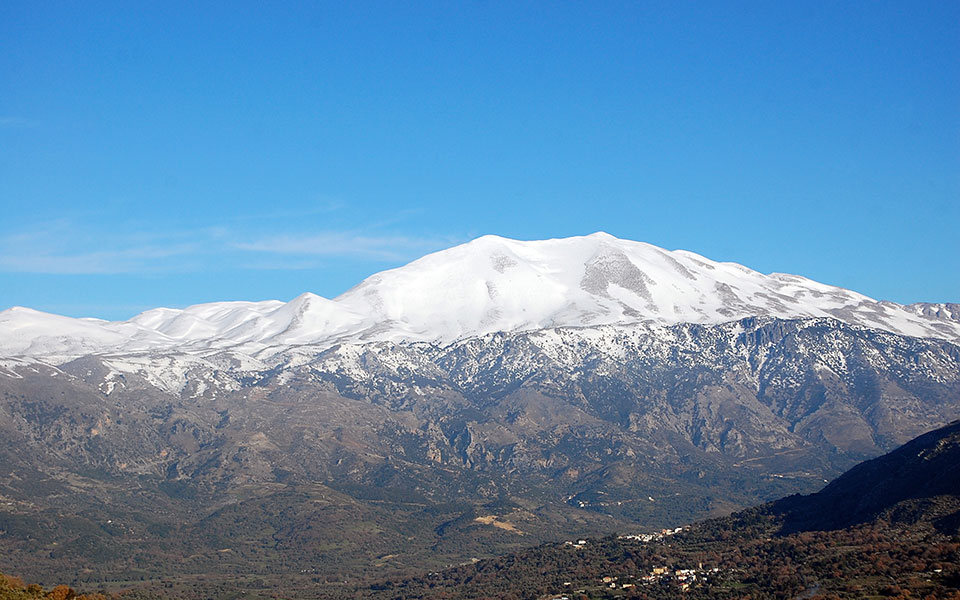 Mount Ida, also known as Psiloritis, reigns as the highest peak on the island of Crete, soaring to 2,456m above sea level.
Mount Ida, also known as Psiloritis, reigns as the highest peak on the island of Crete, soaring to 2,456m above sea level. © Shutterstock
Mount Ida, also known as Psiloritis, reigns as the highest peak on the island of Crete, soaring to 2,456m above sea level.© Shutterstock
Mount Ida: Birthplace of a God
Long before the Olympian Zeus hurled thunderbolts across the Greek world, an older incarnation of the sky god was venerated high on Mount Ida (Psiloritis), Crete’s tallest peak. Here, in the rugged heart of the Minoan world, lies one of the most extraordinary archaeological sites in the Aegean: Zominthos, a high-altitude palace perched at 1,200 meters, along the ancient pilgrimage route to the sacred Idaean Cave.
Excavations – initiated by the late Greek archaeologist Yannis Sakellarakis and continued after his death in 2010 – have uncovered a sprawling, multi-level complex dating to the 17th century BC. The site reveals signs of elite habitation, sophisticated craftsmanship, and ritual activity. Its unusual elevation suggests a dual purpose: both a seasonal retreat and a ceremonial center, likely serving a priestly elite engaged in mountain worship.
 “Knossos of the Mountain” - Zominthos served as a large religious, political and economic center that replaced in the winter months the role of the Ideon Andron Cave, which was inaccessible.
“Knossos of the Mountain” - Zominthos served as a large religious, political and economic center that replaced in the winter months the role of the Ideon Andron Cave, which was inaccessible. © Shutterstock
“Knossos of the Mountain” - Zominthos served as a large religious, political and economic center that replaced in the winter months the role of the Ideon Andron Cave, which was inaccessible.© Shutterstock
Beyond Zominthos, the trail ascends to the Ideon Andron Cave, long revered as the birthplace of Zeus. According to myth, the infant god was hidden here by his mother Rhea, to protect him from his father, the titan Kronos – known for swallowing his offspring to prevent them from usurping his rule. The cave remained a sacred site for centuries; even Roman emperors sent offerings. Archaeological finds inside include bronze figurines, libation vessels, and ceremonial double axes (labrys) – all emblematic of Minoan and early Greek ritual practice.
Today, the hike up Mount Ida offers a rare convergence of myth, landscape, and archaeological wonder. Starting near Anogia or Livadia, modern trekkers can visit Zominthos before continuing to the cave, nestled in a stark limestone ravine. Though the palace lies in ruins, its terraces and foundations still command the mountain pass, echoing the age-old journey from palace to peak – from power to divinity.
 Mount Lykaion, Arcadia. The site of dark rituals and werewolves.
Mount Lykaion, Arcadia. The site of dark rituals and werewolves. © Shutterstock
Mount Lykaion, Arcadia. The site of dark rituals and werewolves.© Shutterstock
Mount Lykaion: Zeus of the Wolves and the Shadow of Sacrifice
High in the wild heart of Arcadia, where the Peloponnesian landscape turns rugged and remote, rises one of the most ancient and enigmatic sanctuaries of Zeus: Mount Lykaion – “Wolf Mountain.” This is no marble temple or orderly precinct. Here, at 1,400 meters above sea level, Zeus was worshipped in his most primal and chthonic form: Zeus Lykaios, the “Wolf-Zeus,” god of sky and storm, but also of transformation, blood, and fear.
Unlike the Olympian Zeus of cities and councils, the god honored here received his rites beneath the open sky. At the summit of the southern peak (modern-day St. Ilias), sacrifices were made on a massive ash altar – a mound formed over centuries by the accumulated remains of burnt offerings. But what kind of offerings?
 
The ancient traveler Pausanias, writing in the 2nd century AD, visited the site and recounted a chilling taboo: “No one is allowed to enter the inner precinct, and if he does, it is not possible for him to live more than a year afterward” (Description of Greece, 8.38.5). He also recorded local legends of human sacrifice, long dismissed by scholars as myth – or propaganda – until 2016, when excavators uncovered the 3,000-year-old skeleton of an adolescent male within the ash altar itself. The body lay in a carefully arranged pit, surrounded by animal bones and pottery. Whether this was a sacrificial victim remains unconfirmed, but the context is unnerving.
Plato, too, links Lykaion to dark rites. In the Republic (565d–e), he describes a ritual in which a man who unknowingly consumes a portion of human flesh at a sacrificial feast is transformed into a wolf (an early example of “lycanthropy”), condemned to roam the mountains for nine years. If he abstains from human flesh during that time, he may become a man again. Such myths blur the line between history and horror, lending Mount Lykaion an atmosphere unlike any other sanctuary in Greece.
 A view from the summit of Mt. Lykaion, looking east toward the stoa and hippodrome.
A view from the summit of Mt. Lykaion, looking east toward the stoa and hippodrome.
A view from the summit of Mt. Lykaion, looking east toward the stoa and hippodrome.
A view from the summit of Mt. Lykaion, looking east toward the stoa and hippodrome.
Today, the mountain is quieter, but its past still lingers. Archaeologists have revealed remnants of a hippodrome, bathhouse, stoa, and other structures that formed part of the sanctuary complex. For centuries, the mountain hosted the Lykaia, athletic and religious festivals that may even predate the Olympic Games.
Modern travelers can reach the summit via a steep, well-marked trail beginning near the village of Ano Karyes. The ascent takes 1.5 to 2 hours, winding through pine forest and over rocky ridgelines. At the summit, the altar still commands sweeping views of Arcadia, the wind tugging at the silence. Bring water, a hat – and a sense of reverence.
 Mount Hellanion Oros, with the chapel of the Ascension at the peak, from the west.
Mount Hellanion Oros, with the chapel of the Ascension at the peak, from the west. © Hellenic Ministry of Culture
Mount Hellanion Oros, with the chapel of the Ascension at the peak, from the west.© Hellenic Ministry of Culture
Mount Hellanion Oros, Aegina: Zeus of the Rain and the Distant Horizon
Far from the crowds of Athens and the monumental sanctuaries of the mainland, a quieter story unfolds on Aegina’s southern tip. Rising from the rugged interior of the island is Mount Hellanion Oros (532 m), a wind-brushed summit once sacred to Zeus Hellanios, the weather-god and bringer of rain. Today, goats wander its slopes and the sea shimmers in all directions –but in ancient times, this solitary peak drew worshippers seeking divine intercession from the sky.
Though modest in appearance, the sanctuary is among the oldest mountain cult sites in Greece. Archaeological traces suggest activity as early as the 8th century BC, with possible Mycenaean roots reaching back to the Bronze Age. A prehistoric fortification still clings to the western flank, and recent excavations by the Swiss School of Archaeology (2023) have uncovered architectural remains and dozens of artifacts – bronze, ceramic, and stone – hinting at the site’s long use, perhaps even as a place of refuge following the Late Bronze Age collapse around 1200 BC.
 
According to Pausanias, the cult was founded here by Apollo, son of Zeus, following a command from the Delphic oracle during a time of devastating drought. Later, the philosopher Theophrastus, in his writings on meteorological signs, noted that when clouds clustered above Mount Hellanion, heavy rain was sure to follow – a divine weather station, watched by farmers and priests alike.
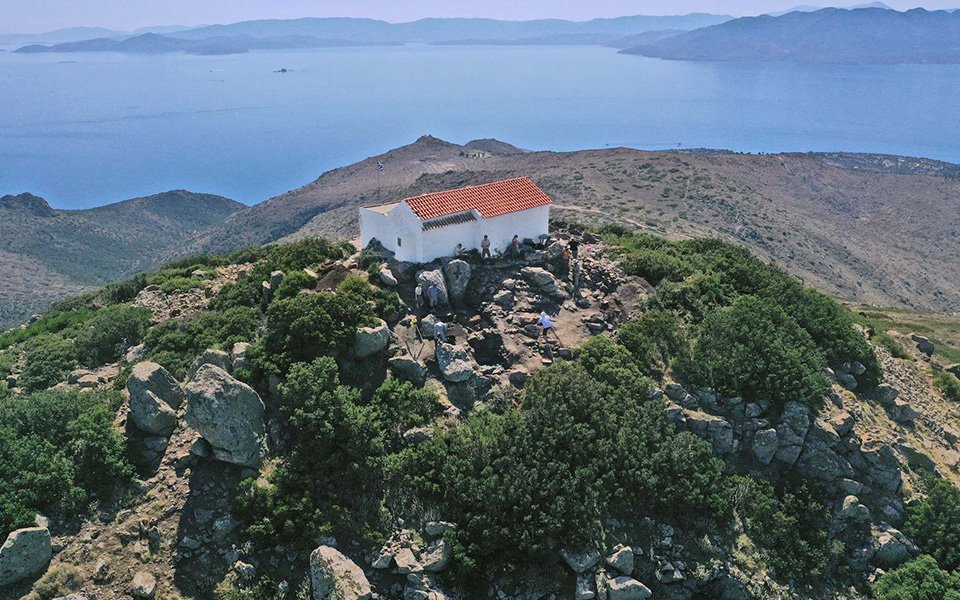 The peak of Mount Hellanion Oros during the 2023 excavation period.
The peak of Mount Hellanion Oros during the 2023 excavation period. © Hellenic Ministry of Culture
The peak of Mount Hellanion Oros during the 2023 excavation period.© Hellenic Ministry of Culture
Fragments of the ancient sanctuary remain scattered around the summit. A foundation of massive stone blocks and fragments of roof tiles lie just beside a small Orthodox chapel, suggesting a temple once stood here, layered beneath centuries of worship. A surviving archaic altar completes the picture of sacred continuity – from Bronze Age ritual to Christian devotion – making this a rare site where belief has outlived stone.
The hike to Mount Hellanion begins near the villages of Anitseo or Sfentouri, winding gently upward through dry slopes scented with wild sage and pine. Though the trail is exposed and best started early in the day, few make the climb, and those who do are rewarded with panoramic views stretching from Athens to the Peloponnese, and across the Saronic Gulf to islands drifting like myth on the horizon.
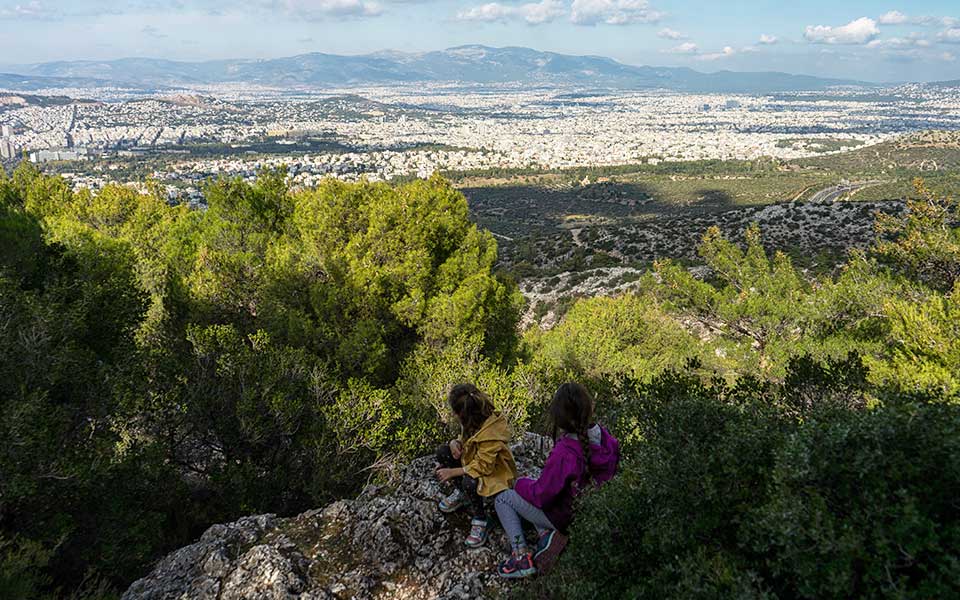 Overlooking Athens, Mount Ymittos is a popular escape for city dwellers.
Overlooking Athens, Mount Ymittos is a popular escape for city dwellers. © Marika Tsouderou
Overlooking Athens, Mount Ymittos is a popular escape for city dwellers.© Marika Tsouderou
Mount Ymittos: Bees and Rustic Gods
Rising to the east of Athens like a silent, green sentinel, Mount Ymittos (Hymettus) is better known today for its honey and hiking trails than for its ancient shrines. Yet in antiquity, this mountain was dotted with places of prayer – caves, springs, and high ridges where Athenians once climbed to seek the favor of Zeus Ombrios, the bringer of rain, along with rustic gods like Pan and the Nymphs.
Though modest in height, Ymittos was a vital piece of Attica’s sacred geography. Pausanias described it as barren of trees, yet fertile in its own way: “Ymittos, although it has no trees, pastures bees excellently” (Description of Greece 1.32.2). And it was to these wild slopes that worshippers came, leaving behind votive offerings, carved niches, and inscriptions in caves and at mountaintop altars.
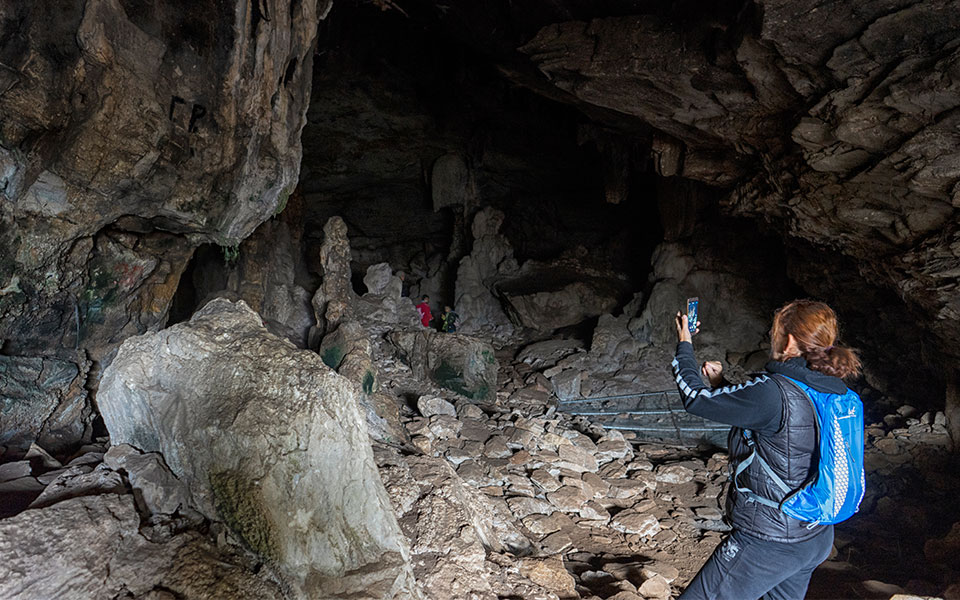 Leontari Cave, found on Trail 14, was used in Classical times as a sanctuary, possibly for the worship of Pan and the nymphs that accompanied him.
Leontari Cave, found on Trail 14, was used in Classical times as a sanctuary, possibly for the worship of Pan and the nymphs that accompanied him. © Marika Tsouderou
Leontari Cave, found on Trail 14, was used in Classical times as a sanctuary, possibly for the worship of Pan and the nymphs that accompanied him.© Marika Tsouderou
The open-air sanctuary of Zeus Ombrios, near the summit of Evzonas (1,026 m), was excavated between the World Wars by American archaeologists Carl Blegen and Rodney Young. The finds revealed two major periods of use: an early phase (950–575 BC) with domestic cups, jugs, and burnt bones suggesting sacrificial rites; and a later one, around 400 AD, with over 120 Late Roman oil lamps. Most striking of all were 170 graffiti inscriptions, revealing a surprisingly high level of literacy among local worshippers as early as the 7th century BC.
However, modern access to the summit – and the scattered remains of the sanctuary itself – is restricted due to a military installation. Hikers can still explore Ymittos via a well-maintained network of trails, especially from the Kaisariani Monastery, whose ancient ruins and peaceful courtyards offer their own glimpse into Attica’s spiritual past. From there, the path winds through pine forests, scattered ruins, and herb-scented slopes. Along the way, you may pass Leontari Cave, another ancient site of rustic devotion to Pan and the Nymphs.
 
For our hiking guide to Mt. Ymittos, click here.
 The twin peaks, Eva in the fore, Ithome in the rear. The view is from the southeast side of Eva looking at the New Monastery in the foreground. Most of the ruins are on the other side.
The twin peaks, Eva in the fore, Ithome in the rear. The view is from the southeast side of Eva looking at the New Monastery in the foreground. Most of the ruins are on the other side.
The twin peaks, Eva in the fore, Ithome in the rear. The view is from the southeast side of Eva looking at the New Monastery in the foreground. Most of the ruins are on the other side.
The twin peaks, Eva in the fore, Ithome in the rear. The view is from the southeast side of Eva looking at the New Monastery in the foreground. Most of the ruins are on the other side.
Mount Ithome: Sanctuary and Stronghold
Returning to the Peloponnese, in the rugged heart of Messenia, Mount Ithome rises like a vigilant sentinel above the plains – its pine-studded slopes and limestone cliffs crowned with ancient walls and sacred stones. For centuries, this summit was more than just a vantage point. It was holy ground, the domain of Zeus Ithomatas, a sky god who watched over a people defined by both devotion and defiance.
The ancient traveler Pausanias visited the site and described a sanctuary dedicated to Zeus, along with a local festival, the Ithomaia, held in his honor (Description of Greece, 4.33.2). But Mount Ithome was not only a place of worship – it was a fortress of resistance. During the Third Messenian War (c. 464–455 BC), following a catastrophic earthquake in Sparta, rebellious helots and Messenian leaders fortified the summit and held out against Spartan domination for over a decade.
 View of Mount Ithome from the theater of ancient Messene.
View of Mount Ithome from the theater of ancient Messene.
View of Mount Ithome from the theater of ancient Messene.
View of Mount Ithome from the theater of ancient Messene.
Archaeological remains on the mountain include Cyclopean walls, shrine foundations, and defensive structures later absorbed into the Byzantine monastery of Voulkano, which still stands today. According to local tradition, an oracle once operated here. The tripod base of that oracle can still be seen embedded in the southeastern corner of the Church of the Panagia of Voulkaniotissa, within the Upper Monastery of Voulkano, or Katholikon, built in the 7th century AD directly on or near the ancient sanctuary.
The climb to Ithome begins in the town of Mavrommati, where a steep but well-marked trail leads up the mountainside. The path threads through wildflowers, buzzing with birdsong in spring, and opens onto panoramic views of the Messinian Gulf, the fertile Pamisos plain, and the distant Taygetos range.
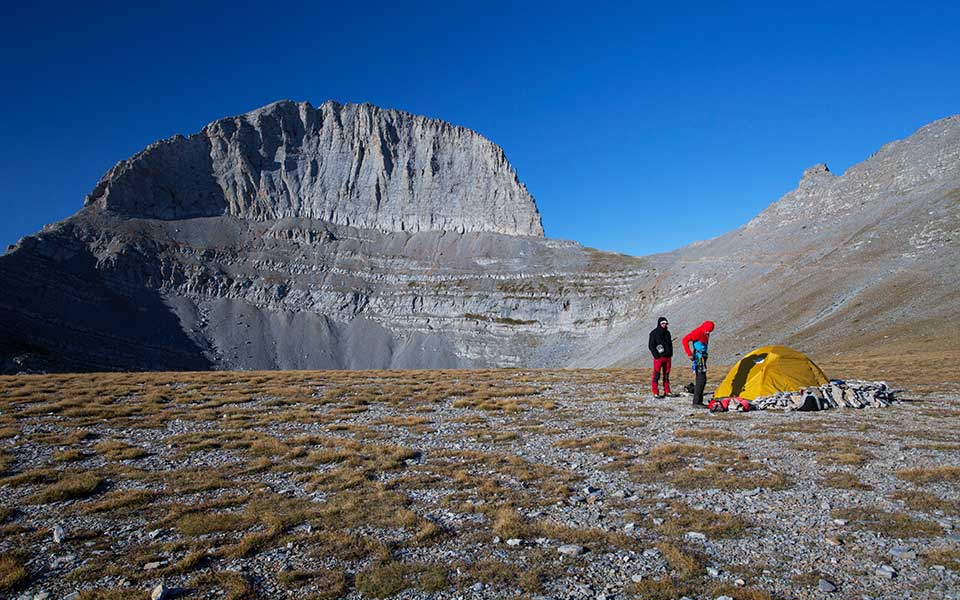 Mount Olympus: The Plateau of the Muses and, towering above it, the Stefani summit, the throne of Zeus.
Mount Olympus: The Plateau of the Muses and, towering above it, the Stefani summit, the throne of Zeus. © Olga Charami
Mount Olympus: The Plateau of the Muses and, towering above it, the Stefani summit, the throne of Zeus.© Olga Charami
Mount Olympus: Home of the Gods
To the ancient Greeks, Mount Olympus was not just the highest point in their world – it was the divine seat of power, where Zeus ruled in thunder, and the Olympian gods held court above the clouds. Rising to 2,918 meters, Olympus is the tallest mountain in Greece, and one of the highest peaks in Europe.
In Homeric Greek, Olympus is portrayed more as a cosmic realm than a precise peak. In the “Odyssey” (6.42) and “Iliad” (5.754), it serves as a celestial space synonymous with the sky (ouranos), not yet anchored to geography. Later interpretations did locate the gods’ home on this real, thunder-split massif, whose storm-prone summits seemed to brush the heavens. Some ancient sources even call Olympus “Mount Belus,” referring to a “heavenly threshold” (Iliad 1.591) – a term rich with cosmic significance.
 
Though no temple ever stood atop its peaks, Olympus was central to ancient Macedonian religious life. At the foot of the mountain lay Dion, a thriving city and sanctuary where Macedonian kings, including Philip II and Alexander the Great, offered sacrifices to Zeus Olympios. Higher up, at spots like the Plateau of the Muses (c. 2,600 m), archaeologists have uncovered votive altars, inscriptions, and the remains of pilgrimage routes – evidence that ancient Greeks ascended the mountain, not just in imagination, but in ritual.
Perhaps the most striking symbol of sacred continuity is the chapel of Profitis Ilias, perched on the summit of the same name at 2,803 meters. Built in the 16th century by Saint Dionysios of Olympus, it is the highest-standing chapel in the Balkans, often snowbound and windswept even into summer. Today, it still hosts annual liturgies at sunrise.
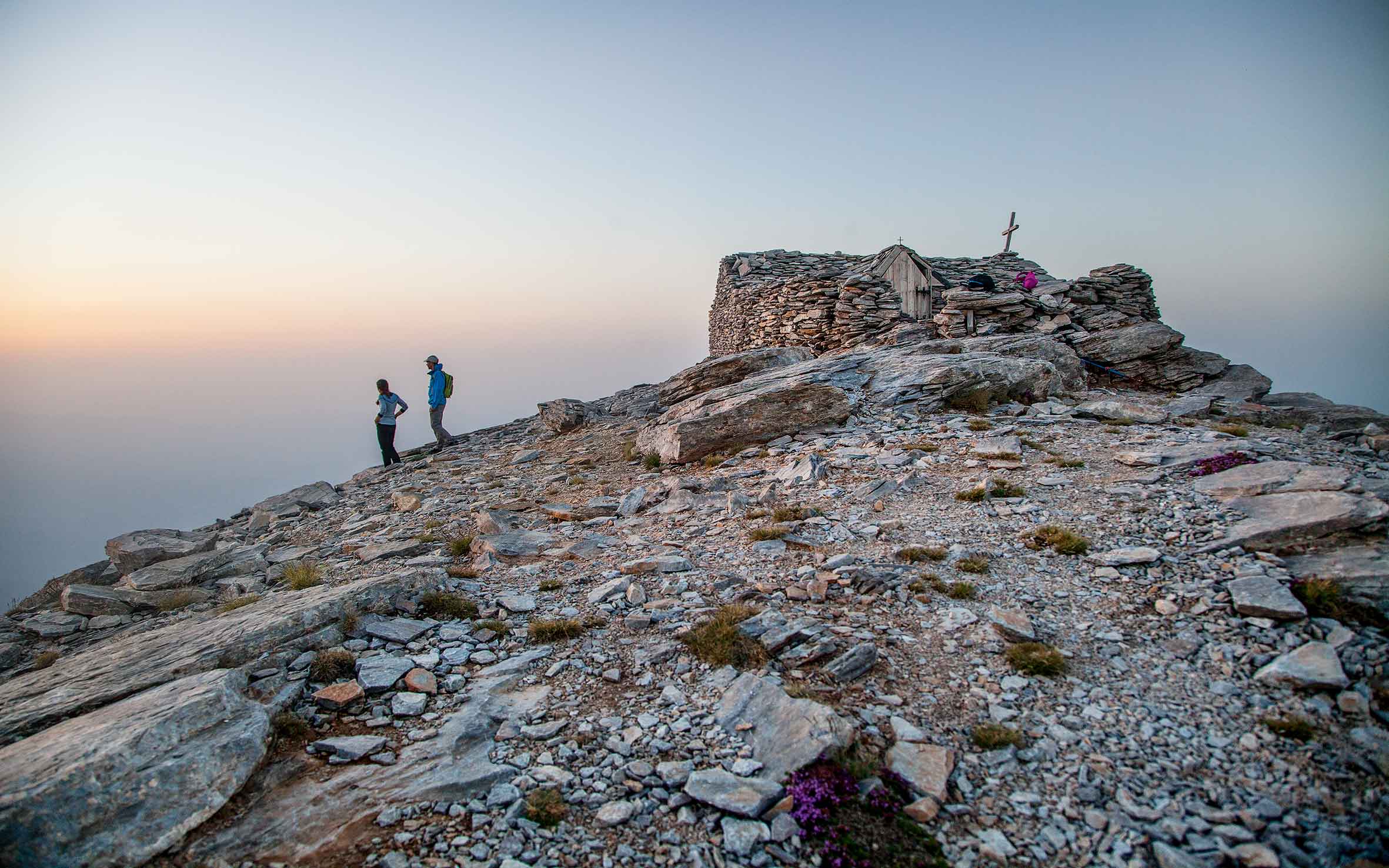 On Profitis Ilias Peak, with the chapel of the same name.
On Profitis Ilias Peak, with the chapel of the same name. © Olga Charami
On Profitis Ilias Peak, with the chapel of the same name.© Olga Charami
Modern travelers typically begin their ascent from Litochoro, on the eastern flank of the mountain. The E4 European long-distance trail leads through the Enipeas Gorge, a lush passage of waterfalls, dense forest, and stone bridges, before reaching Prionia, a key rest point at 1,100 meters.
From there, most hikers continue to Refuge Spilios Agapitos (2,100 m), a popular overnight stop. Those aiming to summit Mytikas, the true peak, must tackle a steep and exposed scramble – classified as a YDS Class 3 or moderate climb – best suited to experienced hikers or guided groups. For a slightly easier goal, Skolio Peak (2,911 m) offers jaw-dropping views without the same technical demands.
 
Click here for our travel guide to Mount Olympus.
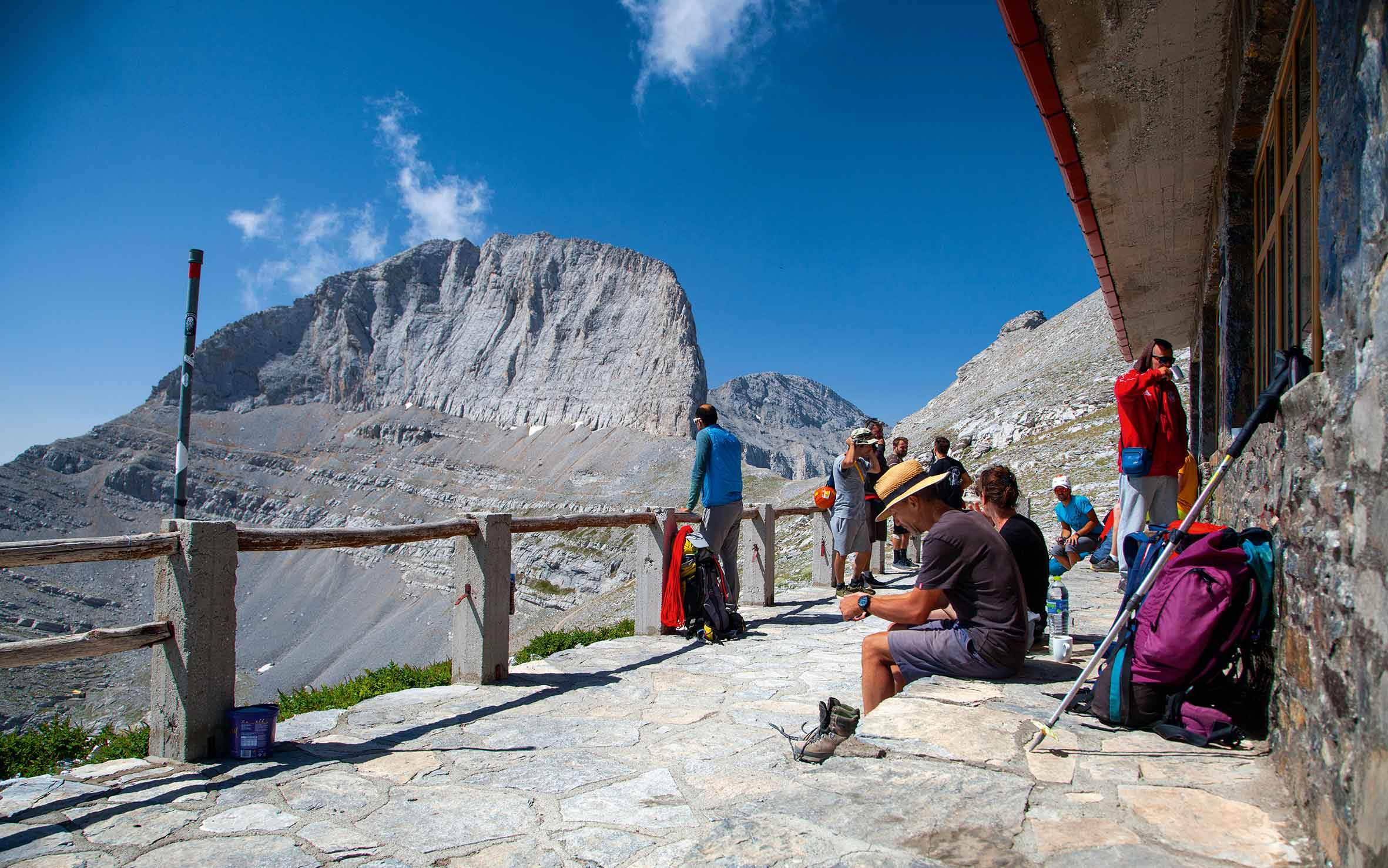 The imposing Stefani Peak on Mount Olympus, as seen from Giosos Apostolidis Refuge.
The imposing Stefani Peak on Mount Olympus, as seen from Giosos Apostolidis Refuge. © Olga Charami
The imposing Stefani Peak on Mount Olympus, as seen from Giosos Apostolidis Refuge.© Olga Charami
Sacred Heights
From the wind-scoured slopes of Mount Ida to the cloud-bound heights of Olympus, Greece’s mountain sanctuaries form a quiet constellation of ancient belief. Though scattered across the landscape, they share more than altitude. Nearly all were dedicated to Zeus – not the marble-seated Olympian of later temples, but his older, wilder forms: Zeus Ithomatas, Lykaios, Ombrios, Hellanios – gods of rain, storms, judgment, and the raw forces of nature.
These peaks were more than places of worship. They were thresholds between the human and the divine, between valley life and sacred sky. Some served as refuges and rallying points, like Ithome, stronghold of the Messenian resistance. Others marked tribal borders or hosted regional festivals that predated even Olympia.
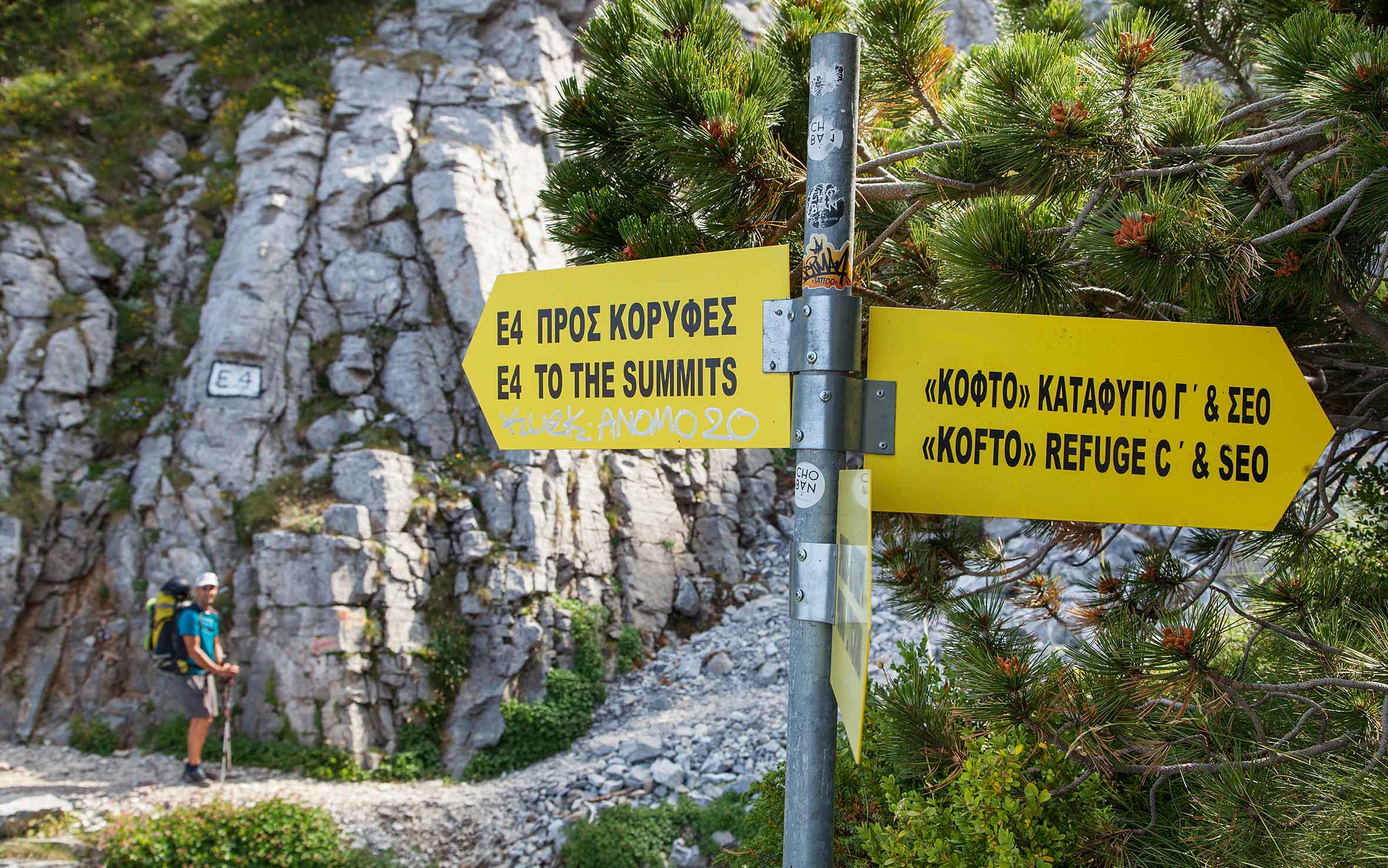 Different routes to the summit present different grades of difficulty.
Different routes to the summit present different grades of difficulty. © Olga Charami
Different routes to the summit present different grades of difficulty.© Olga Charami
For modern travelers, these heights still offer something profound: a chance to connect myth, memory, and landscape. May is the perfect time to explore – trails are dry, days are long, and wildflowers bloom on every ridge.
Accessible routes include Mount Hellanion Oros (Aegina) and Mount Ymittos, both offering sweeping views and light, half-day hikes.
 
Mount Ithome and Mount Lykaion require more effort but reward with solitude, historical resonance, and commanding vistas.
Mount Olympus is the most demanding. Reaching Mytikas – the true summit – requires proper gear, experience, or a certified mountain guide. Weather can change rapidly, and the final scramble is exposed and technical.
Whichever peak you choose, go prepared: bring plenty of water, sun protection, sturdy footwear, and a charged phone or GPS device. Respect local signage, pack out what you bring in, and tread gently – in many respects, these are still sacred places.
At their heart, these mountains are not just ruins or relics. They are living landscapes, shaped by gods, weather, and the quiet footsteps of pilgrims. With care and curiosity, you may still hear the wind carry an ancient voice – just as the Greeks once did, high on their sacred heights.

 2 months ago
110
2 months ago
110








 Greek (GR) ·
Greek (GR) ·  English (US) ·
English (US) ·